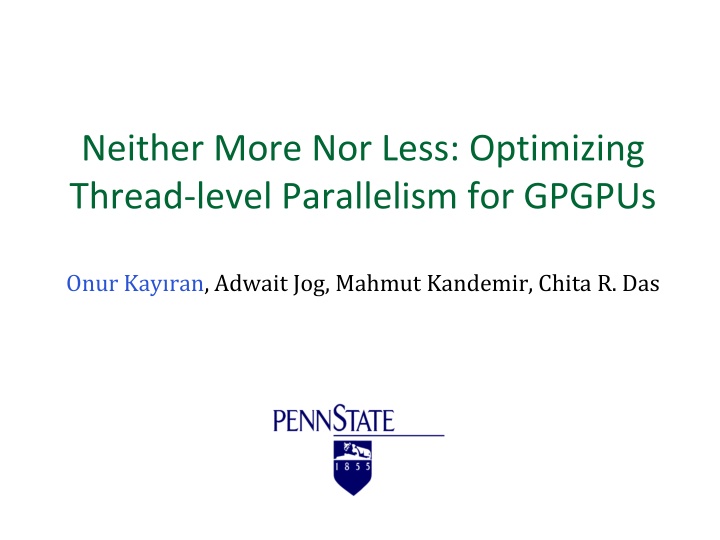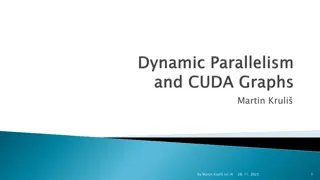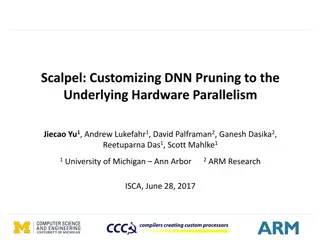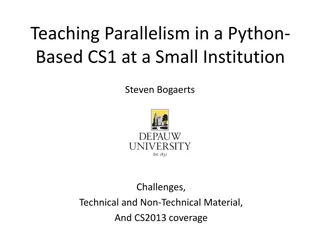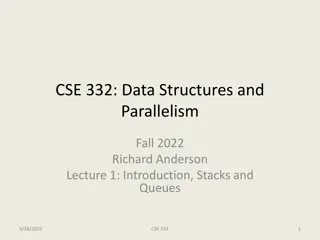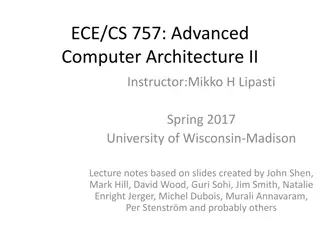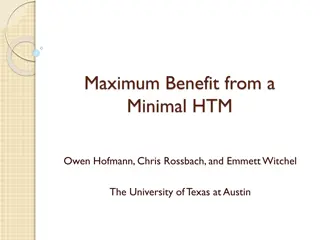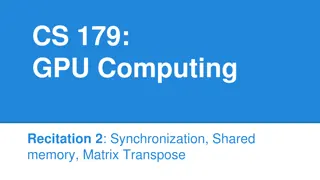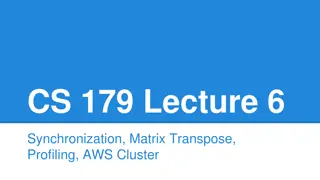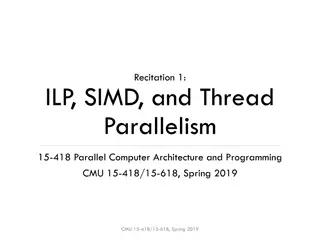Optimizing Thread-level Parallelism for GPGPUs
This research focuses on optimizing thread-level parallelism for GPGPUs to enhance application performance by reducing memory subsystem contention. The study proposes a novel thread-block scheduling algorithm to maximize thread-level parallelism and improve overall efficiency. Detailed analysis of GPU architecture, scheduling techniques, and properties of CTAs are presented to address the challenges associated with multi-core GPUs. The study showcases a 28% improvement in average application performance through optimized thread-level parallelism.
Download Presentation

Please find below an Image/Link to download the presentation.
The content on the website is provided AS IS for your information and personal use only. It may not be sold, licensed, or shared on other websites without obtaining consent from the author.If you encounter any issues during the download, it is possible that the publisher has removed the file from their server.
You are allowed to download the files provided on this website for personal or commercial use, subject to the condition that they are used lawfully. All files are the property of their respective owners.
The content on the website is provided AS IS for your information and personal use only. It may not be sold, licensed, or shared on other websites without obtaining consent from the author.
E N D
Presentation Transcript
Neither More Nor Less: Optimizing Thread-level Parallelism for GPGPUs Onur Kay ran, Adwait Jog, Mahmut Kandemir, Chita R. Das
GPU Computing Uni-processors Multi-cores Many-cores, GPUs ... Core Core Core Core Core ... GPUs are known for providing high thread-level parallelism (TLP). 2
Too much of anything is bad, but too much good whiskey is barely enough - Mark Twain 3
Executive Summary Current state-of-the-art thread-block schedulers make use of the maximum available TLP More threads more memory requests Contention in memory sub-system Proposal: A thread-block scheduling algorithm Optimizes TLP and reduces memory sub-system contention Improves average application performance by 28% 4
Outline Proposal Background Motivation DYNCTA Evaluation Conclusions 5
GPU Architecture Threads SIMT Cores Scheduler W CTA W CTA W W CTA W CTA W CTA Warps Warp Scheduler ALUs L1 Caches Cooperative Thread Arrays (CTAs) Interconnect L2 cache DRAM 6
GPU Scheduling CTA Scheduler CTA Scheduler CTA CTA CTA CTA CTA CTA Pipeline Pipeline W W W W W W W W Warp Scheduler Warp Scheduler Warp Scheduler Warp Scheduler 7
Properties of CTAs Threads within a CTA synchronize using barriers. There is no synchronization across threads belonging to different CTAs. CTA Threads CTAs can be distributed to cores in any order. Once assigned to a core, a CTA cannot be preempted. barrier 8
Properties of CTAs The number of CTAs executing on a core is limited by: the number of threads per CTA the amount of shared memory per core the number of registers per core a hard limit (depends on CUDA version for NVIDIA GPUs) the resources required by the application kernel These factors in turn limit the available TLP on the core. By default, if available, a core executes maximum number of CTAs. 9
Outline Proposal Background Motivation DYNCTA Evaluation Conclusions 10
Effect of TLP on GPGPU Performance Minimum TLP Optimal TLP 39% potential improvement 3.3 4.9 1.9 1.6 2.4 2.4 3.0 3.5 4.9 1.4 19% 1.2 Normalized IPC 1 0.8 0.6 0.4 0.2 11
Effect of TLP on GPGPU Performance 51% 1 Ratio (RACT) Active Time 16% 0.8 0.6 0.4 0.2 0 Minimum TLP Optimal TLP 3.3 4.9 1.9 2.4 1.6 95% potential improvement 3.5 4.9 3.0 2.4 Normalized IPC 1.4 1.2 1 0.8 0.6 0.4 0.2 12
Why is not more TLP always optimal? AES AES MM MM 1.4 1.4 1.2 1.2 Normalized Value Normalized Value Normalized Value Normalized Value 1.2 1.2 1 1 1 1 0.8 0.8 0.8 0.8 0.6 0.6 IPC IPC 0.6 0.6 IPC lat. IPC lat. 0.4 0.4 0.4 0.4 0.2 0.2 0.2 0.2 0 0 0 0 1 1 2 2 3 3 4 4 1 1 2 2 3 3 4 4 5 5 6 6 7 7 8 8 Number of CTAs per core Number of CTAs per core Number of CTAs per core Number of CTAs per core JPEG JPEG CP CP 1.2 1.2 1.4 1.4 Normalized Value Normalized Value Normalized Value Normalized Value 1.2 1.2 1 1 1 1 0.8 0.8 0.8 0.8 0.6 0.6 IPC IPC 0.6 0.6 IPC lat. IPC lat. 0.4 0.4 0.4 0.4 0.2 0.2 0.2 0.2 0 0 0 0 1 1 2 2 3 3 4 4 5 5 6 6 7 7 8 8 1 1 2 2 3 3 4 4 5 5 6 6 7 7 8 8 Number of CTAs per core Number of CTAs per core Number of CTAs per core Number of CTAs per core 13
Why is not more TLP always optimal? More threads result in larger working data set Causes cache contention More L1 misses cause more network injections Network latency increases BP BP 1.2 1.2 1 1 Normalized Value Normalized Value 0.8 0.8 L1 data miss rate 0.6 0.6 L1 data miss rate Network lat. 0.4 0.4 0.2 0.2 0 0 1 1 Number of CTAs per core Number of CTAs per core 2 2 3 3 4 4 14
Outline Proposal Background Motivation DYNCTA Evaluation Conclusions 15
DYNCTA Approach Execute the optimal number of CTAs for each application Requires exhaustive analysis for each application, thus inapplicable Idea: Dynamically modulate the number of CTAs on each core using the CTA scheduler 16
DYNCTA Approach Objective 1: keep the cores busy If a core has nothing to execute, give more threads to it Objective 2: do not keep the cores TOO BUSY If the memory sub-system is congested due to high number of threads, lower TLP to reduce contention If the memory sub-system is not congested, increase TLP to improve latency tolerance 17
DYNCTA Approach Objective 1: keep the cores busy Monitor C_idle, the number of cycles during which a core does not have anything to execute If it is high, increase the number of CTAs executing on the core Objective 2: do not keep the cores TOO BUSY Monitor C_mem, the number of cycles during which a core is waiting for the data to come back from memory If it is low, increase the number of CTAs executing on the core If it is high, decrease the number of CTAs executing on the core 18
DYNCTA Overview C_idle H L C_mem H M L No Increase # of CTAs Decrease # of CTAs change in # of CTAs 19
CTA Pausing Once assigned to a core, a CTA cannot be preempted! Then, how to decrement the number of CTAs ? CTA PAUSE Warps of the most recently assigned CTA are deprioritized in the warp scheduler 20
Outline Proposal Background Motivation DYNCTA Evaluation Conclusions 21
Evaluation Methodology Evaluated on GPGPU-Sim, a cycle accurate GPU simulator Baseline Architecture 30 SIMT cores, 8 memory controllers, crossbar connected 1300MHz, SIMT Width = 8, Max. 1024 threads/core 32 KB L1 data cache, 8 KB Texture and Constant Caches GDDR3 800MHz Applications Considered (in total 31) from: Map Reduce Applications Rodinia Heterogeneous Applications Parboil Throughput Computing Focused Applications NVIDIA CUDA SDK GPGPU Applications 22
Dynamism Average Number of CTAs Default number of CTAs 8 Average Number of CTAs 6 Optimal number of CTAs 4 2 0 Time Active Time Ratio 1 Active Time Ratio 0.8 0.6 0.4 0.2 0 Time 23
Dynamism Average Number of CTAs Default number of CTAs 8 Average Number of CTAs 7 6 5 Optimal number of CTAs 4 3 2 1 0 Time Active Time Ratio 1 Active Time Ratio 0.8 0.6 0.4 0.2 0 Time 24
Average Number of CTAs 2.9 2.7 5.4 Default Default Default DYNCTA DYNCTA DYNCTA Optimal TLP Optimal TLP Optimal TLP 8 8 8 Average Number of CTAs/core Average Number of CTAs/core Average Number of CTAs/core 6 6 6 4 4 4 2 2 2 0 0 0 25
IPC 39% 28% TL TL TL DYNCTA DYNCTA DYNCTA Optimal TLP Optimal TLP Optimal TLP 2.9 2.9 3.6 1.6 1.6 1.6 3.3 3.3 1.9 13% 3.5 3.5 3.5 4.9 4.9 4.9 3.0 3.0 3.0 2.4 2.4 2.4 1.4 1.4 1.4 Normalized IPC Normalized IPC Normalized IPC 1.2 1.2 1.2 1 1 1 0.8 0.8 0.8 26
Outline Proposal Background Motivation DYNCTA Evaluation Conclusions 27
Conclusions Maximizing TLP is not always optimal in terms of performance We propose a CTA scheduling algorithm, DYNCTA, that optimizes TLP at the cores based on application characteristics DYNCTA reduces cache, network and memory contention DYNCTA improves average application performance by 28% 28
THANKS! QUESTIONS? 29
BACKUP 30
Utilization CTA 1 Core 1 Idle CTA 3 CTA 5 CTA 7 CTA 2 Core 2 CTA 4 CTA 6 CTA 8 Core 1 CTA 1 CTA 3 CTA 4 CTA 6 Core 2 Idle CTA 5 CTA 8 CTA 7 CTA 2 31
Initial n All cores are initialized with N/2 CTAs. Starting with 1 CTAs and N/2 CTAs usually converge to the same value. Starting with the default number of CTAs might not be as effective 32
Comparison against optimal CTA count Optimal number of CTAs might be different for different intervals for applications that exhibit compute- and memory- intensive behaviors at different intervals Our algorithm outperforms optimal number of CTAs in some applications 33
Parameters Variable Description Value Nact Active time, where cores can fetch new warps Ninact Inactive time, where cores cannot fetch new warps Active time ratio, Nact/(Nact + Ninact) RACT C_idle The number of core cycles during which the pipeline is not stalled, but there are no threads to execute The number of core cycles during which all the warps are waiting for their data to come back Threshold that determines whether C_idle is low or high Thresholds that determine if C_mem is low, medium or high The number of cycles to make a modulation decision C_mem t_idle 16 t_mem_l & t_mem_h 128 & 384 Sampling period 2048 34
Round Trip Fetch Latency Round Trip Fetch Latency 1.6 0.67 1.4 Normalized Latency 1.2 1 0.8 0.6 0.4 0.2 0 35
Other Metrics L1 data miss rate: 71% 64% Network latency: 33% Active time ratio: 14% 36
Sensitivity Large system with 56 and 110 cores: around 20% performance improvement MSHR size: 64 32 16: 0.3% and 0.6% performance loss DRAM frequency: 1333 MHz: 1% performance loss Sampling period 2048 4096: 0.1% performance loss Thresholds: 50% - 150% of the default values: losses between 0.7% - 1.6% 37
